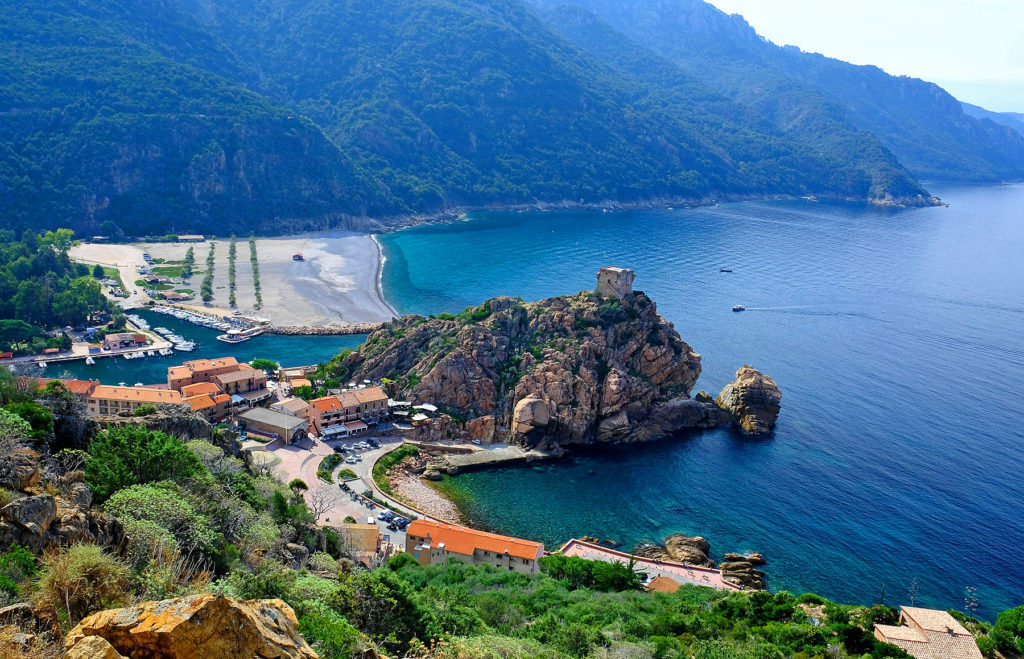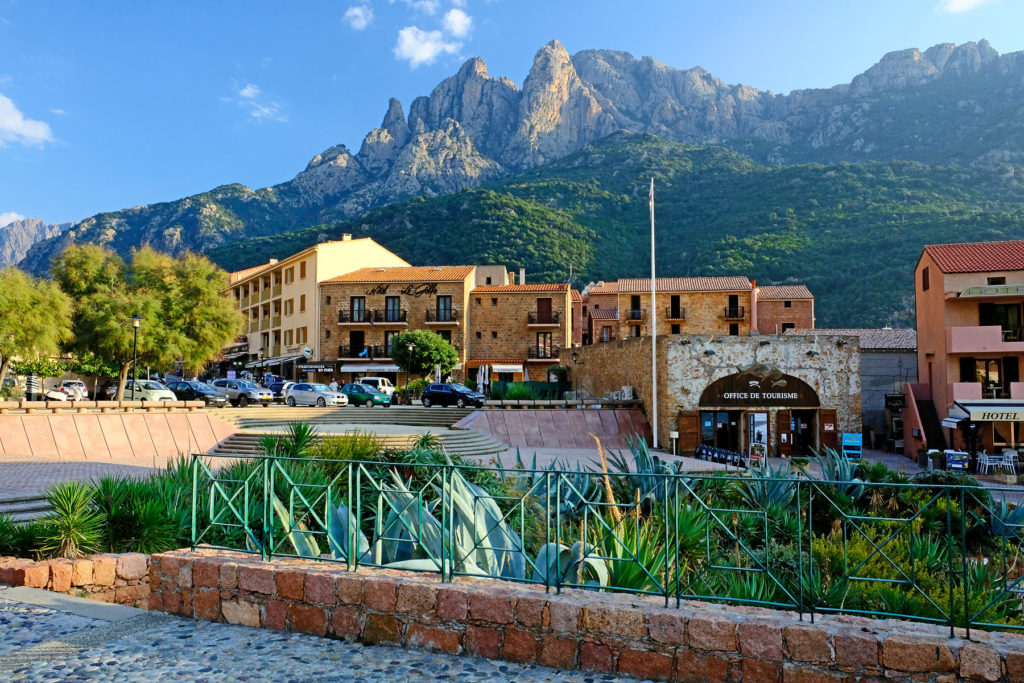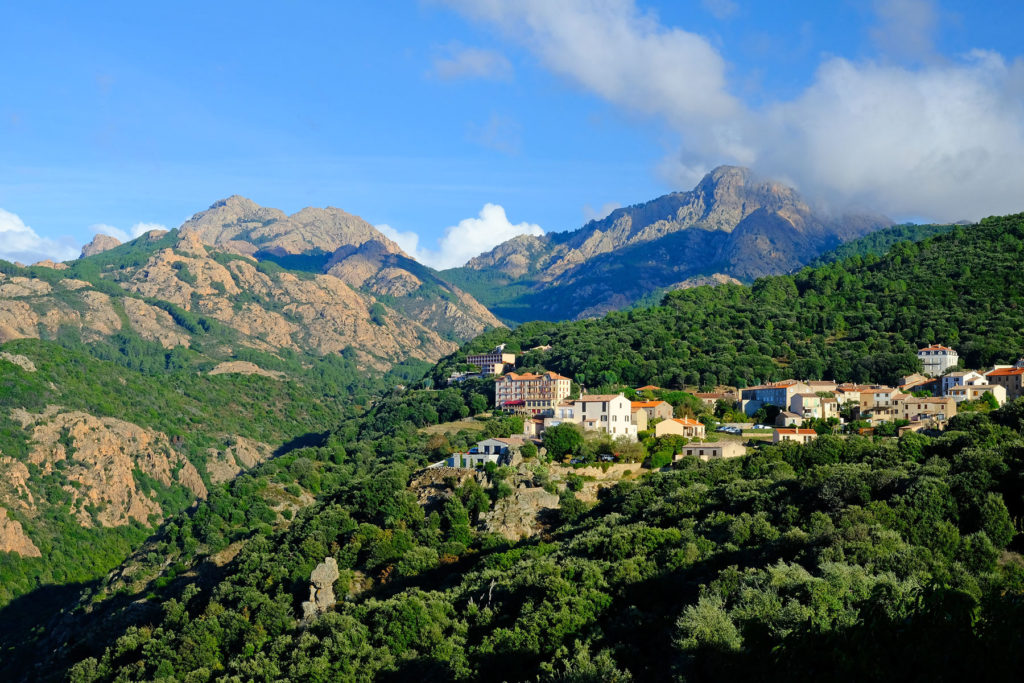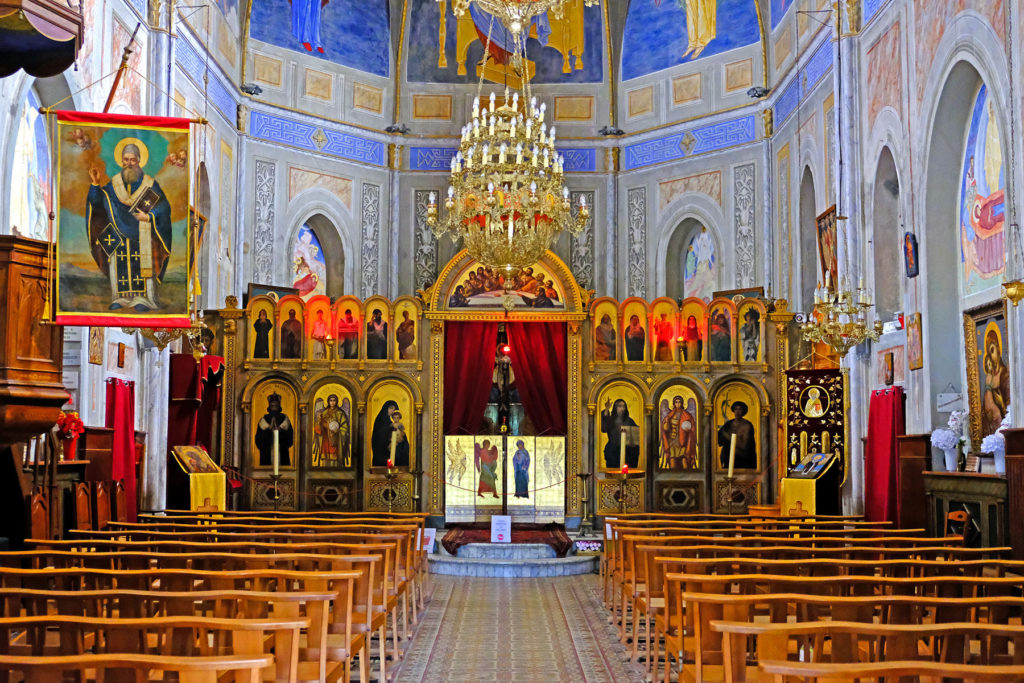
Explore Porto, Piana, and Cargèse, three extraordinary villages located on Corsica’s famous northwest shores. Set against a striking backdrop of snow-capped peaks, these charming hamlets offer access to some of the island’s most spellbinding scenery where giant red cliffs plunge into deep blue bays. Each one is unique, with distinct historic heritage, traditions, and feel – all make for a perfect base to experience Corsica’s legendary beauty.
This page contains affiliate links meaning I get a commission if you decide to make a purchase through my links, at no extra cost to you. Click here to learn more.

PORTO – A CAPTIVATING PORT TOWN SET IN DRAMATIC SCENERY
Fringed by kilometers of rugged red granite coastline dotted with numerous world-class scenic landmarks, Porto serves as the main tourist hub of the region. Renowned for its spectacular sunsets, it occupies a privileged position hidden away in a UNESCO-protected bay bearing its name.
This enchanting port town has a small marina from where a flotilla of boats sets off to tour the most attractive corners of Corsica’s shoreline. A handful of hotels, restaurants, and boutiques borders the main street which often gets congested in high season.
At the top of the village, an imposing Genoese tower rises from a giant rock overlooking the bay and its small pebbly beach to the south. Majestic pinnacles of the surrounding mountains with the summit of Capo d’Orto (1294 m) add to the landscape’s drama further accentuating the remoteness and ethereal atmosphere of Porto.

PORTO – ATTRACTIONS
- Enjoy a boat trip to the natural treasures of the Scandola Reserve, a UNESCO World Heritage Site where rigorous protection laws have allowed the preservation of the astounding marine and terrestrial biodiversity. The fascinating amphitheater of orange cliffs and translucent waters is home to Girolata, a small fishing hamlet only accessible by sea or by foot. This idyllic spot dominated by a 17th-century watchtower is a perfect place for a relaxing lunch at one of the wood-carved bars by the beach. Various operators offer Scandola tour services with different formulas and prices (50-75 €).
- Discover Porto’s Genoese watchtower rising from a rocky promontory at an altitude of 45 m. Built in 1549 as part of the coastal defense system, its function was to alert the local population in the event of Saracen and pirate raids. The tower’s rare square shape makes it look more like a fortified castle, with its terrace affording stupendous views of the Gulf. Renovated in 1993, it now houses a permanent exhibition on the history of Corsica’s defense towers and their role in the protection of the island. You may access the structure via a windy path carved in the granite rock. A small fee includes entry to the Aquarium.
- Visit Aquarium da la Poudrière to view over 150 marine species inhabiting the Gulf of Porto. Situated in the square opposite the tower, the former powder house shelters 11 pools particularly popular with kids and younger visitors.
- Relax on Porto’s pebbly beach located in the southern part of the bay. The dazzling cove offers dramatic panoramas and excellent snorkeling opportunities in its deep waters. Parking spaces are available along the road behind the beach.
- Explore Calanches de Piana, Corsica’s emblematic rocky universe of granite sculptures dropping directly into the vast expanse of the Mediterranean. Visited by car, on foot or in a boat tour, this unique geological landmark is one of the island’s top attractions.
- Set off on one of Corsica’s most memorable road journeys through Gorges de Spelunca. The scenic D84 route between Porto and Evisa opens up to striking 1000 m high granite walls boarded by a lively torrent. 22 km of arresting twists and turns may be navigated within 40 minutes.
- Visit the most attractive beaches of the Gulf’s northern shores- Bussaglia, Caspio, and Gradelle. Exposed to the island’s enchanting scenery, the wild coves are renowned for glorious sunsets illuminating the red walls of the Calanches.
- Hike from Evisa to Ota along a Genoese mule track descending to the Spelunca Gorge. Meandering through dense chestnut and holm oak forests this fairly easy 3h long trek is well marked with orange paint. Numerous bathing spots provide an opportunity to cool off in hot summer months.
- Dive in the exceptionally translucent deep waters of the Porto Bay. Diving schools located in the town’s marina offer courses for beginners or accompaniment for more experienced divers. Detailed information may be found at www.plongeeporto.com, www.bleaumarineplongee.com.
BOOK YOUR BOAT TRIP FROM PORTO TO SCANDOLA AND CALANCHES DE PIANA
- Scandola Reserve and Girolata boat trip. A 3 to 4-hour-long boat journey to the iconic coast with a 30-minute stop in the village of Girolata. The boat is equipped with comfortable shaded areas whereas the information leaflet is available in French, English, and Italian. Learn more and book here.
- Calanches de Piana, Scandola and Girolata boat tour. A 3-hour-long exciting excursion to the landmarks of the northwest coast of Corsica. A small semi-rigid allows to enter caves and navigate close to the cliffs. Learn more and book here.
- Capo Rosso, Calanches de Piana and Scandola boat tour. A 3-hour-long trip on a family-friendly boat to the Scandola Reserve and Calanches de Piana. During your excursion, you will enjoy a swimming break. Snorkeling gear is provided and the vessel is adapted for children. Learn more and book here.
- Semi-submarine visit to the seabed of Porto Bay. View and explore the fauna and flora of the seabed of the Bay of Porto and the Calanches. Two circuits are offered depending on weather conditions. If you are lucky you may even spot the dolphins. Learn more and book tickets here.
PRACTICAL INFORMATION
- Details concerning bus connections between Porto and other Corsican towns may be found at www.corsicabus.org. Coaches to and from Ajaccio run all year round. Tickets may be purchased on the bus.
- Porto’s friendly tourist office is located in the square opposite the Genoese Tower.
- The post office situated at Rue Principalo provides an ATM for withdrawals of cash.
- Despite its small size and geological constraints, Porto has a relatively large number of car parks and parking spaces. In summer, however, with the seasonal influx of visitors, the town gets very congested.
- There are several small supermarkets within the Porto. Spar and Carrefour are located at the entrance of the village by the pharmacy while Proxy may be found in the port.

PIANA – ONE OF THE MOST BEAUTIFUL VILLAGES IN FRANCE
Perched 438 m above sea level 12 km south of Porto, Piana enjoys five-star views of the entire Gulf. Surrounded by some of the island’s most famous landscapes it grants easy access to the region’s top attractions- eroded red rocks of the Calanches, the Reserve of Scandola, and pristine wild coves harboring abundant wildlife. Hikers are spoilt for choice with numerous iconic walks suitable for all fitness levels. Capu Rossu or Chateau Fort are beginner-friendly destinations that offer outstanding panoramas of the area.
In the 15th century, Piana was a seat of the Lords of Leccia, a Corsican noble family that resided in a medieval castle located 4 km south of the village. In 1489, following a rebellion against the Genoese, the Seigneurs were slaughtered along with the whole male population. It wasn’t until 1690 that the hamlet was reconstructed in the form of an amphitheater with the church occupying a central position.
Today, Piana is ranked among the most beautiful villages in France. Its tidy narrow lanes are bordered by traditional stone buildings still oozing much of its old character. In season, this otherwise quiet village flourishes with exuberant tourist activity focused around local restaurants, bars, and boutiques.

PIANA – ATTRACTIONS
- Visit Eglise de l’Assumption, a baroque-style church built in 1765-92. Two noteworthy artifacts may be admired inside the building- a painting of Saint Hugh of Lincoln dating back to the 17th century and a wood-carved statue of the Assumption.
- Savour a glass of refreshing Corsican wine on the terrace of the Les Roches Rouges hotel. This chic period building erected at the beginning of the 20th century used to welcome aristocracy for winter months. Decorated in the original art deco style, it boasts lovely frescos, original furniture, and fittings. However, it is the sweeping views across the coast that are the hotel’s top asset.
- Snorkel in the perfectly translucent waters of Anse de Ficaghjola, a magnificent sand/pebble cove located a few kilometers west of Piana. Navigating the narrow windy road that descents 350 m down to the beach should only be attempted by very experienced drivers. Hairpin bends and vertiginous cliff-edge drops assure an exhilarating drive. Owing to its heavenly setting at the foot of imposing red rock walls, the beach gets overcrowded in high season.
- For the best views in the region, climb the summit of Capo d’Orto (1294 m) towering above the western landscapes. This iconic 12 km long trek requires good physical health and dry weather conditions. Its departure point is located 1.7 km north of Piana on the D81 road.
- Enjoy a leisurely afternoon on the golden sands of Plage d’Arone, the region’s most beautiful beach. Situated 12 km southwest of the village of Piana, this stunning 750 m wide bay is a treasure trove for nature enthusiasts. Surrounded by scented Mediterranean vegetation with orche rock formations protecting crystalline waters Arone enjoys a truly enchanting setting. Due to its isolated position, the beach was chosen as the drop-off point of arms by the Casabianca submarine to the Corsican Resistance forces during World War II. To access the cove, take the D824 road running west towards Vistale and Arone. The scenic drive grants unforgettable views of the majestic Capu Rossu and the rugged shores of Golfe de Porto. In season, the beach is supervised whereas friendly restaurants offer delicious meals.
- Climb the craggy peak of Capu Rossu (331 m), one of Corsica’s most emblematic landmarks inscribed on the UNESCO World Heritage List. The 331 m high rocky pyramid is crowned with a restored Genoese tower dominating the superb scenery of the island’s dramatic shores. The trail starts on the D824 route 6 km west of Piana.
PRACTICAL INFORMATION
- For bus connections between Piana and Ajaccio check the online timetable at www.corsicabus.org.
- Piana’s tourist office is located at Rue de la Mairie in the building of Casa Cumuna di Piana.
- Due to its extraordinary geographic position, parking spaces in the village are limited. A small car park with fabulous views of the bay is situated next to the A Casa Corsa restaurant. You may also find free parking by the church.
- Utile Piana, a small supermarket providing essential supplies is situated at the southern entrance of the village on D81.
- An Esso petrol station is located on the same road 100 m from the supermarket.

CARGESE – A CONGENIAL TOWN WITH GREEK HERITAGE
The charming village of Cargèse sat on a hill above the Gulf of Sagone is famous for its fascinating history of Greek colonization.
In the 17th century, a group of around 700 Peloponnese fleeing the oppression of the Ottoman Empire sought refuge on Corsican soil. The Republic of Genoa who controlled the island at the time granted the newcomers land in the region of the present village of Cargèse. Prospering colonists established five hamlets, several churches, and a monastery. Over time, however, tensions rose between the Greeks and the local Corsican community who resented the immigrants’ close links with the Genoese rulers.
Following a violent conflict in 1732, the Peloponnese took refuge in Ajaccio, to return to Cargèse 40 years later at the beginning of the French reign.
Slowly, feuding populations learned to peacefully coexist, and primarily through intermarriage, the immigrants assimilated fully into the local society. Two remarkable churches, one Eastern, the other one Latin, face each other rising from a promontory above sparkling Mediterranean waters. Shaded by mature olive trees both afford amazing views of the bay in silent testimony of old animosities between two rivaling cultures.
Present-day Cargèse thrives as an enchanting tourist destination. The best way to soak up its relaxing atmosphere is to stroll down the attractive lanes flanked by elegant white homes. Vibrant Booneville flowers decorate village squares where friendly bars and restaurants provide an opportunity to taste local specialties. The postcard-perfect setting of Cargèse is complemented by the proximity of sublime sandy beaches and scenic walks.

CARGESE – ATTRACTIONS
- Discover extraordinary churches of Cargèse, Latin, and Greek, built opposite each other by two distinct cultures. Works on the Catholic Eglise de l’Assomption started in 1825 and lasted till 1850. With a yellow façade and a square bell tower, the church represents the late Baroque style. The interior is composed of a central nave with two side chapels. Evocative trompe l’oeil paintings decorating the ceiling were executed in 1928-30 by a Russian painter Nicolas Ivanoff who lived in the village. A School of Bologna 17th-century depict exposed above the entrance is a gift from the city of Ajaccio to Cargèse presented in 1865. The Greek Eglise Saint-Spyridon was erected between 1852-76 by the descendants of the original Peloponnese refugees. Neo-Gothic in style, the building has a white façade crowned with a bell tower. The spectacular neoclassical interior is decorated with vibrant frescos but it is the iconostasis (a wooden partition separating the sanctuary from the congregation) that defines the sacred space. Richly covered with holy images this exquisite feature was a gift from a monastery in Rome brought to the island by the colonists in the 17th century. Weekly liturgies are conducted in both churches by the parish priest.
- Visit the best beaches in the area- Menasina, Pero, and Chiuni. To reach Plage de Menasina park your car 3 km south of Cargèse on D81 where a clearing in the shrub leads to a path descending to the beach. With clear turquoise water and fine white sand, this secluded 200 m wide cove is a perfect hideaway for lovers of unspoilt nature. As there are some pebbles on the shore, a pair of aqua shoes will allow you to easily enter the water. Plage de Pero is located 1.5 km north of Cargèse with easy access via a road running parallel to its shores. The golden sandy curve of Pero stretches for 900 m between two rocky headlands protecting it from strong winds. Shelving steeply, its intensely blue seaweed-free waters provide superb swimming conditions. Several beach services include bars, restaurants, and a watersports rental. Beyond Pionte d’Omigna north of Pero lies Plage de Chiuni, a shallow 800 m long white-sand cove. With easy access from the D81 road this beautiful beach is popular with families and young visitors but also enthusiasts of water sports. Until 2019, the southern part of Chiuni was occupied by a lively Club Med holiday village, now awaiting either requalification or reconstruction of its grounds.
- Enjoy a rewarding walk to Tour de l’Omigna, a 17th-century tower situated at the end of a narrow headland enclosing Plage de Pero from the north. The 6.8 km long round trip takes around 2.5 h. The path starts at the end of the cul-de-sac street running behind the beach. This easy trek is suitable for families with children although due to some stony passages comfortable hiking shoes are indispensable. Wonderful views of Capu Rossu and Iles Sanguinares are best appreciated during the afternoon hours when the golden rays of the setting sun illuminate rocky formations.
- For wilder landscapes of raw Corsican nature head to Tour d’Orchinu rising from a rocky peninsula at the northern end of Golfe de Chiuni. Although the trek traversing scented maquis isn’t well marked the tower is clearly visible from the path. The 2 h long round trip accessible to everyone in good physical shape is exposed to the rugged scenery of plunging cliffs, home to a multitude of endemic wildlife species.
- Sample delicious fresh fish and seafood served in the marina of Cargèse. An idyllic location with views of the harbour, a relaxing atmosphere, and a vast choice of tasty dishes are the perfect ingredients to shape the most memorable holiday experiences.
- Discover the exceptional beauty of Corsica’s submarine and terrestrial life during a boat tour. Fabulous natural sites such as the Reserve of Scandola, Capu Rossu, or the Calanches of Piana may be visited aboard comfortable vessels departing from the port in Cargèse. A variety of operators and transport options allows you to choose a formula that may best suit your preferences.
BOOK YOUR BOAT TRIP FROM CARGESE TO SCANDOLA AND CALANCHES DE PIANA
- Scandola, Girolata and Calanques de Piana day cruise. 7-hour-long trip aboard a comfortable boat with shaded areas, toilets, and a bar. Includes a visit to the most iconic places of the reserve with a 2-hour stop in Girolatta and a break for swimming. Learn more and book here.
- Discovery tour to Capo Rosso, Scandola, Calanques de Piana, and Girolata. A friendly 6-hour-long cruise to Scandola aboard a medium-sized boat with experienced and attentive sailors. You will enjoy a 2-hour break in the picturesque village of Girolata. Learn more and book tickets here.
- Calanches de Piana, Scandola, and Girolata boat trip. A 4.5-hour-long speedboat tour of the emblematic scenic sights with a swimming break and a 30-minute stop in Girolata. Commentary may be provided in various languages. Learn more and book tickets here.
PRACTICAL INFORMATION
- S.A.S.A.I.B. (Autocar Ile de Beaute) runs bus connections between Ajaccio and Ota with a stop in Cargèse. Transfers operate daily except on Sundays and bank holidays.
- Detailed information concerning accommodation and local attractions is available at the local tourist office at Rue du Dr Dragacci.
- The post office is located on the main D81 road in the center of the village.
- There is a large car park with spaces for buses at the top of the village by the main roundabout. Parking places in the center are limited and difficult to come by in high season.
- You may withdraw cash from a local Banque Populaire Méditerranée ATM situated on D81 at the northern exit of the village.
- Essential supplies may be purchased at a sizable Spar supermarket located at Chem. De Paomia in the northern part of Cargèse.
HELPFUL TRAVEL RESOURCES :
Please help support CoolCorsica!
If you find this website as useful as a guidebook you may have had to buy to plan your travels please consider helping me with a small donation.
This all-content, ads-free site is created in my spare time with a desire to share comprehensive information, useful tips, and inspiring photos of Corsica’s most scenic locations.
With your generous help, I can continue to offer my advice and support in planning your dream holiday.
Thank you for your contribution!
